

OCLC Linked Data Research. SWIB - Semantic Web in Libraries - Programme. LodLive - browsing the Web of Data. State of the LOD Cloud. In order to discover as many Linked Data sources as possible, we have crawled a snapshot of the Linked Data Web.

We used the LDSpider linked data crawler. We seeded LDSpider with 560 thousand seed URIs originating from the datahub.io dataset catalog, the Billion Triple Challenge 2012 dataset as well as from datasets being advertised on the public-lod@w3.org mailing list. With those seeds, we performed crawls during April 2014 to retrieve entities from every dataset using a breadth-first crawling strategy.
Datasets not allowing crawlers were not included in our corpus. Altogether, we crawled 900,129 documents describing 8,038,396 resources. Linked Data technologies are being using to share data covering a wide range of different topical domains. The image below gives an overview of the linkage relationships between datasets. In total, 56.11% of the crawled datasets link to at least one other dataset.
The tables below show the ten datasets with the highest in- and outdegrees. 22545B.pdf. LDBCouncil. Linked Open Vocabularies. The oldest RDF vocabularies have been published at the turn of the century just after the first RDF specification, in 1999.
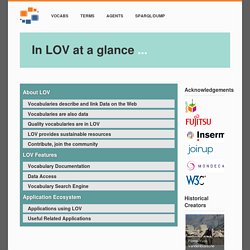
Since then, thousands of them have been published and used. Some are stable recommendations, published by standard bodies like the W3C or the Dublin Core Metadata Initiative. Some are library metadata formats provided by the Library of Congress or other large national libraries (BnF, DNB, etc.). Many more are published and used by actors as diverse as large media corporations such as BBC, national administrations such as INSEE, the European Community, universities and research projects, and some are just published by individuals and put on the community table, in the tradition and spirit of the open, collaborative Web. And a growing number has been forgotten by their publishers, have broken URIs or obsolete content, although their terms can still be found in data. Linked Data for Libraries (LD4L) - Linked Data for Libraries. Walk Before You Run: Prerequisites to Linked Data. The Universe in a Glass of Wine: Richard Feynman on How Everything Connects, Animated.
OCLC Linked Data Research. Linked Data Survey results 3–Why and what institutions are consuming (Updated) OCLC Research conducted an international linked data survey for implementers between 7 July and 15 August 2014.
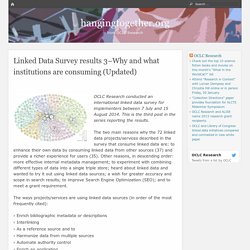
This is the third post in the series reporting the results. The two main reasons why the 72 linked data projects/services described in the survey that consume linked data are: to enhance their own data by consuming linked data from other sources (37) and provide a richer experience for users (35). Other reasons, in descending order: more effective internal metadata management; to experiment with combining different types of data into a single triple store; heard about linked data and wanted to try it out using linked data sources; a wish for greater accuracy and scope in search results; to improve Search Engine Optimization (SEO); and to meet a grant requirement. Linked Data Survey results: Examples in production. OCLC Research conducted an international linked data survey for implementers between 7 July and 15 August 2014.
This is the second post in the series reporting the results. The survey received responses describing 38 linked data projects/services that are in production and accessible to others. American Antiquarian Society’s General Catalog, which includes the North American Imprints Program. American Numismatic Society’s thesaurus of numismatic concepts, used by archeological projects and museum databases, Archives, biographies, and online corpus of Roman imperial coins.
OpenGlam - Open Collections. One big library. Last week I attended code4lib north at McMaster University in Hamilton.
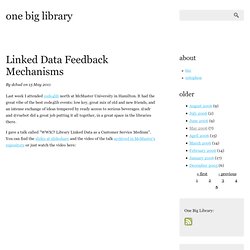
It had the great vibe of the best code4lib events: low key, great mix of old and new friends, and an intense exchange of ideas tempered by ready access to serious beverages. @adr and @ruebot did a great job putting it all together, in a great space in the libraries there. I gave a talk called "WWIC? Open Data Portal. The Digital Agenda Scoreboard The Digital Agenda Scoreboard web application allows you to interactively create graphs to view the data you are interested in.
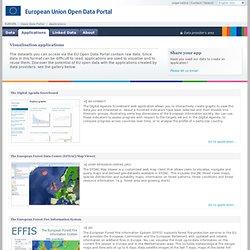
About a hundred indicators have been selected and then divided into thematic groups, illustrating some key dimensions of the European information society. You can use these indicators to assess progress with respect to the targets set out in the Digital Agenda, to compare progress across countries over time, or to analyse the profile of a particular country.The European Forest Data Centre (EFDAC) Map Viewer Joint Research Centre (JRC)The EFDAC Map Viewer is a customised web map client that allows users to visualise, navigate and query maps and derived geo-datasets available in EFDAC. This includes the JRC forest cover maps, species distribution and suitability maps, information on forest patterns, forest conditions and forest resource information. One big library. Swib13/slides/boehme_swib13_131.pdf. Culturegraph. Reflections on the 2013 Linked Open Data in Libraries Archives and Museums Summit - DigitalNZ.
Linked data is an amazing yet elusive idea—elusive for at least two reasons.

It can be difficult for people who don't live and breathe linked data to grasp. It also remains difficult for institutions to know where to start in providing linked data views of their collections. At DigitalNZ we have been exploring these issues both internally and with some of our content partners. This blog post provides a brief overview of what linked data is and offers some reflections on a recent linked open data summit. Day two LODLAM session schedule by Jon Voss The conventional Web is beautiful in its simplicity—anyone can link any online document to any other online document. Visualization. Library exchange at Purdue University Libs. There are various impressive data services and initiatives, which can be found from the Purdue University Libraries.
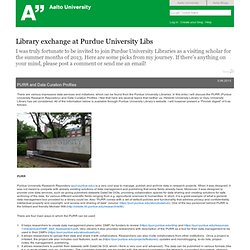
In this entry I will discuss the PURR (Purdue University Research Repository) and Data Curation Profiles. I feel that here are several topics that neither us, Helsinki University Library or Oulu University Library has yet considered. All of the information below is available through Purdue University Library’s website. I will however present a “Finnish digest” of it as follows. Purdue University Research Repository (purr.purdue.edu) is a very cool way to manage, publish and archive data in research projects. There are four main ways in which the PURR can be used: Research.microsoft.com/pubs/193076/Whitepaper on Linking Structured Data.pdf. BIBFRAME - Bibliographic Framework Initiative. LibraryCloud. Open Data and Preservation. Yesterday, May 9, 2013, the U.S. government issued an executive order and an open data policy mandating that federal agencies collect and publish new datasets in open, machine-readable, and, whenever possible, non-proprietary formats.
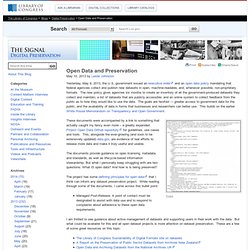
The new policy gives agencies six months to create an inventory of all the government-produced datasets they collect and maintain; a list of datasets that are publicly accessible; and an online system to collect feedback from the public as to how they would like to use the data. Bookworm Open Library. Journalism in the Age of Data: A Video Report on Data Visualization by Geoff McGhee. The Open Data Economy. Databases & Linked Data. LinkedData. Opendata. Welcome to Open Data Protocols — Open Data Protocols - Simple Open Standards for Open Data. Amazon Kindle X-Ray Demo. Your Timeline Submissions Wanted for the Open Book. The Finnish Institute in London and the Open Knowledge Foundation are publishing a book, and we want you to be a part of its history. The Open Book (publish date 2013, details here) is a crowd-sourced publication which will contextualise the international open knowledge movement in the words of those who are helping build it today.
This book, based on the ideas of more than 1,000 participants from over 50 nations who came together in to attend the world’s first Open Knowledge Festival this September in Helsinki, will highlight the hopes and motivations of those currently working to promote global change, and introduce the movement to new audiences. Based on pieces coming from a variety of leaders working in fields as diverse as sustainability, design, business and development, The Open Book will serve as a platform for discussion and a launching pad for new ideas about the future of a global movement in a time of rapid technological and societal change.
Www.niso.org/apps/group_public/download.php/9408/IP_Fons-etal_OCLC_isqv24no2-3.pdf. Torre de Belém (Lisbon, Portugal) Www.niso.org/apps/group_public/download.php/9410/IP_Stevenson_LinkingLives_isqv24no2-3.pdf.